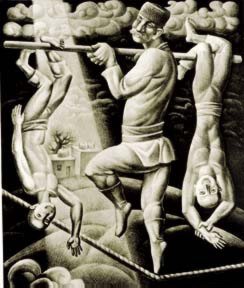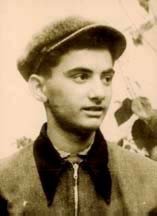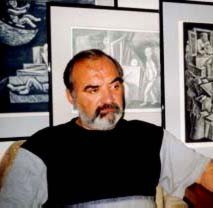|
Winter
1999 (7.4) Famous People:
Then and Now
Left: Arif Alasgarov at age 15 in 1959. Right: Arif Alasgarov in late 1990s. Arif Alasgarov (pronounced a-RIF a-las-GAR-ov) is featured on the Internet at AZgallery.org. He is known for his illustrations, lithographs and paintings. _____ What experiences and interests in childhood would you say shaped your life and career? I don't remember when I first started drawing, but my father used to say that I showed an interest when I was 2 or 3 years old. I drew flowers and people but I liked drawing horses most of all. I think art was in my genes. My grandfather was an amateur artist. We had a large still - life painting in our home that my grandfather had done that I liked so much. Anyway, at the age of 11, I started attending Drawing Circle. How was your own childhood different from that of kids growing up today? Lithograph: Rope Dancers by Alasgarov, 1982.  I showed my painting to Rasim Babayev, a well - known Azerbaijani artist, who liked it: "I'll keep this and show it to you when you grow up," he told me. Many years later, he showed me it to me; he had kept through the years and I was so pleased. Later I entered the Azim Azimzade Art Institute. That's when I began illustrating books. During my childhood there were few artists although many aspired to be. For example, each year there were only 10 positions allocated at the Arts College for the Painting Faculty and three for the Sculpture Faculty. Some people were so eager to become artists that they kept trying for several years to get admitted. Today more places are allotted for students but they don't seem to put as much effort into their studies. I teach at the Arts Institute and I sense this. When I went to school, students were eager to learn, but today most just go to school to get a diploma. Of course, there are still some very talented students nowadays, but in comparison to the past, that number is very small. Maybe it's because of the economic situation in our country. When you ask a student why he missed class, he says that he didn't have bus fare. You don't know what to say. You can't reprimand him. But if someone really wants to be a professional artist, he will somehow manage to study night and day and support his family financially at the same time. Everything depends on what you want. What advice would you give to young people as they enter the 21st century? I want the youth to be optimistic and to believe in a better future. My advice is: Work and work. It's work that supports a man and enables him to reach his goals. I always tell my students: "Use every minute. You have teachers here, you have all the equipment here. After you graduate, you won't have all this. Use every minute." What would you say is your greatest achievement in life? What do you want to be remembered for most? My works are like children for me. You never know who to caress, who to take good care of. Just like the members of your family, you want them to grow, to develop. You even expect more of them, hoping that they can even be better.
Back to Index
AI 7.4 (Winter 1999) |


